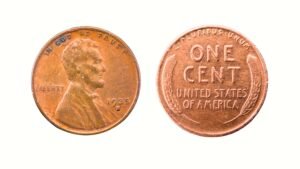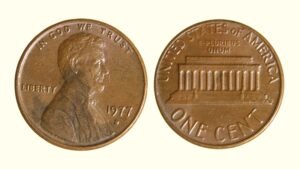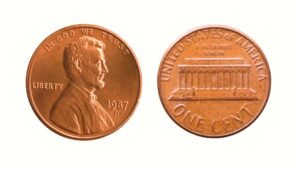Does your coin collection have a small 1999 Lincoln Penny? If yes, you just became rich! A rare example of this small cent was sold for a whopping $138,000! But are all 1999 Lincoln cents worth huge amounts? If not, how to spot the one that is? Find all answers in this guide explaining all rare features that make a 1999 Lincoln Memorial Cent valuable!

Brief History of the 1999 Lincoln Memorial Penny
The 1999 Lincoln Memorial penny represents one of the final years of the memorial reverse design. By 1999, the Lincoln Cent had been a common part of American commerce for 90 years, carrying the iconic portrait of Abraham Lincoln on its obverse and Frank Gasparro’s Lincoln Memorial reverse design that had replaced the original wheat ears motif in 1959.
This penny was struck at the three major mints: Philadelphia, Denver, and San Francisco, with the last one only creating special collector versions. The late 1990s also saw growing interest in modern variety collecting, thanks to rare varieties like the Wide AM variety first found in 1998 and continuing into 1999.
| 1999 Lincoln Penny | Key Features & Facts |
| Material Composition | Copper-plated Zinc (97.5% Zinc & 2.5% Copper) |
| Minting Location | Philadelphia, Denver, San Francisco |
| Minting Year | 1999 |
| Face Value | 1 cent ($0.01) |
| Weight | 2.5 grams |
| Diameter | 19 mm |
| Thickness | 1.55mm |
| Designer | Victor D. Brenner (Obverse), Frank Gasparro (Reverse) |
| Mint Marks | ‘D,’ ‘S’ and No mint mark |
| Total Mintage | 11,601,012,966 coins |
How to Identify a 1999 Lincoln Memorial Cent
The 1999 Lincoln Memorial penny is fairly straightforward to identify, but you must pay close attention to its design and composition to authenticate it. Here’s an overall of all its physical features:
1990 Lincoln Penny Obverse:

- A right-facing portrait of Abraham Lincoln, the 16th President of the States
- The minting year ‘1999’ on the lower right side
- ‘IN GOD WE TRUST’ on the top
- ‘LIBERTY’ in compact kerning to Lincoln’s left
- The mint mark “D” or “S” (if present) below the mint date
1990 Lincoln Penny Reverse:
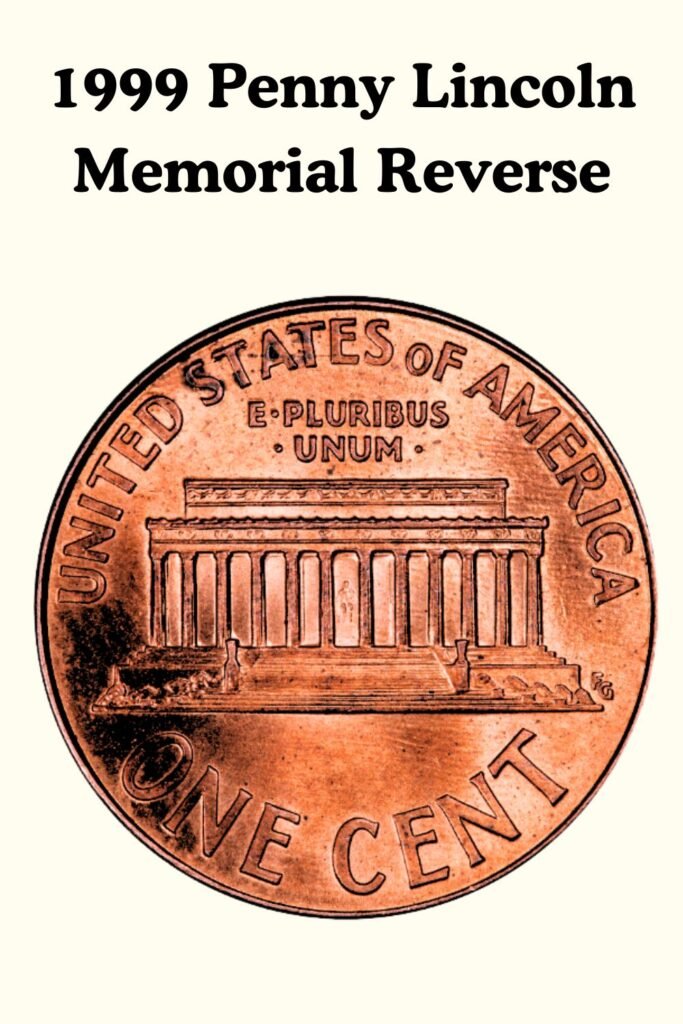
Coin Composition, Size, and Dimensions
The 1999 Lincoln Memorial Cent follows the modern copper-plated zinc composition established in 1982, consisting of a zinc core (97.5%) plated with a thin layer of copper (2.5%). This metallic structure maintains the traditional copper color while costing lesser than the earlier solid copper composition.
As for its physical features, the 1999 penny weighs exactly 2.5 grams and measures 19.05 millimeters in diameter, with a thickness of 1.55 millimeters. The edge is smooth with a clean finish that distinguishes it from other denominations.
Remember to verify the above details to confirm your 1999 Lincoln Cent is authentic. If any of the features don’t match, it could hint at a counterfeit.
Finding the Value of 1999 Lincoln Memorial Penny
A typical 1999 Lincoln Memorial penny in circulation is worth its face value of one cent. However, uncirculated specimens can range from 25 cents to several thousand dollars, depending on condition, color, mint mark, and the presence of valuable varieties or errors, such as the Wide AM.
1. Coin Grading and Color
The condition of a 1999 Lincoln Memorial penny plays a crucial role in determining its value. Generally, the coins are assessed on a grading scale ranging from P-1 to MS-70, where higher grades mean better condition.
As for the values, Mint condition grades ranging from uncirculated pieces in MS-60 to MS-63 typically bring 25 cents to $1. MS-64 examples command $1-3, while MS-65 specimens can bring $3-10. MS-66 pieces worth $10-30 and MS-67 pennies potentially reach $20-40.
MS-68 and MS-69 1999 pennies are the rarest, fetching around $50 to $1,000 or more, particularly those with special varieties like the Wide AM!
The color of a Lincoln cent is another important aspect of condition assessment influencing its value. There are generally three color grades or designations: Red (RD, at least 95% of their original color), Red-Brown (RB, between 15% and 94% of original red color), and Brown (BN, less than 15% of original red color).
Among these, Red 1999 Lincoln pennies command the highest premiums, particularly fetching $5 to $2,000 or more in MS65 or above grades! Red-Brown and Brown pennies don’t fetch a lot unless they are a rare variety or have a mint error.
2. 1999 Lincoln Penny Mint Marks & Mintage
| Coin Grades | Condition Details | 1999 No Mint Mark Penny Value | 1999 D Penny Value |
| Poor (0) to Extremely Fine (XF45) | Significant wear, faded but visible details | 1-3 cents | 1.3 cents |
| Almost Uncirculated (AU50) to Mint State (AU58+) | Slight wear on highest points, visible marks or blemishes | 20 cents to 50 cents | 10 cents to 30 cents |
| Mint State (MS60 – MS64) | Uncirculated with minimal wear | $1 – $5 | $1 – $6 |
| Mint State (MS65 – MS66+) | Nearly flawless with very minor imperfections | $5 – $15 | $7 – $10 |
| Mint State (MS67 – MS67+) | Well-preserved with no major flaws | $20 – $40+ | $10 – $20+ |
| Mint State (MS68 – MS68+) | Nearly perfect, luster, no major marks or flaws | $50 – $200+ | $20 – $50+ |
| Mint State (MS69 or Above) | Almost perfect coin | N/A | $250 – $1,200+ |
The mintage of a coin depends how rare and valuable it is; the lower the mintage, the rarer the coin! The 1999 Lincoln Memorial had a high mintage of over 11.6 billion, making it quite common.
But the penny was minted at three different locations: the Philadelphia Mint, the Denver Mint, and the San Francisco Mint. Each mint used a different mark to identify where the coin was struck, which also impacts its value.
1999 No Mint Mark Penny Value (Mintage – 5,237,600,000)
The Philadelphia Mint, producing coins with no mint mark, struck over 5.23 billion pennies in 1999. Due to high mintage, circulated 1999 no mint mark pennies are worth only 1-3 cents.
Uncirculated Red examples in Gem Mint State can fetch decent prices. For example, MS65 1999 no mint mark penny typically brings $3-8, while MS66 and MS67RD specimens can command $20-40. The rare MS-68RD pieces can reach $50 to $200!
1999 D Lincoln Penny Value (Mintage – 6,360,065,000)
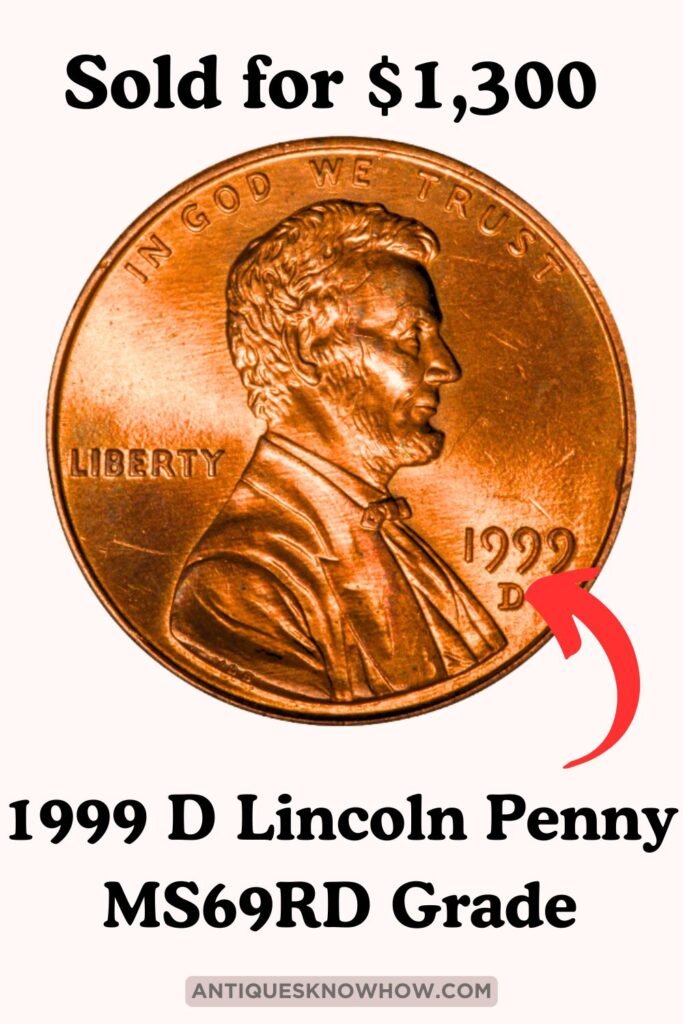
With over 6.3 billion 1999 Lincoln cents with the D mint mark, the 1999 D penny is slightly more common than the Philadelphia examples. While a circulated 1999 D Lincoln cent is worth 1-3 cents, MS-65RD examples can sell for $4-10. MS-66 and MS67RD cents can also bring $10-20, with MS68 examples reaching $20-50.
This coin is also found in the rare MS69 grades that can reach $250 to $1,200, like this example sold for almost $1,300 on Heritage Auctions!
3. 1999 Proof Lincoln Memorial Pennies
The San Francisco Mint only procured proof pennies in 1999, with its total mintage reaching 3,347,966 coins. These coins bear a small S mint mark on the obverse and feature superior design quality and finish compared to circulation strikes, with deeply mirrored fields.
The value of proof 1999 Lincoln cents mainly depends on grades but the color designation also remains important for proofs, with Red specimens commanding the highest premiums.
These coins were also stuck in Close AM and Wide AM varieties. Since Wide AM proof cents are quite common, those with Close AM are more desirable and valuable, with DCAM or Ultra Cameo proof examples selling for $20-50 in PR-65, $50-100 in PR67 grades, $100-170 in PR68 grades, and $130-$200 or more in PR69 or higher grades!
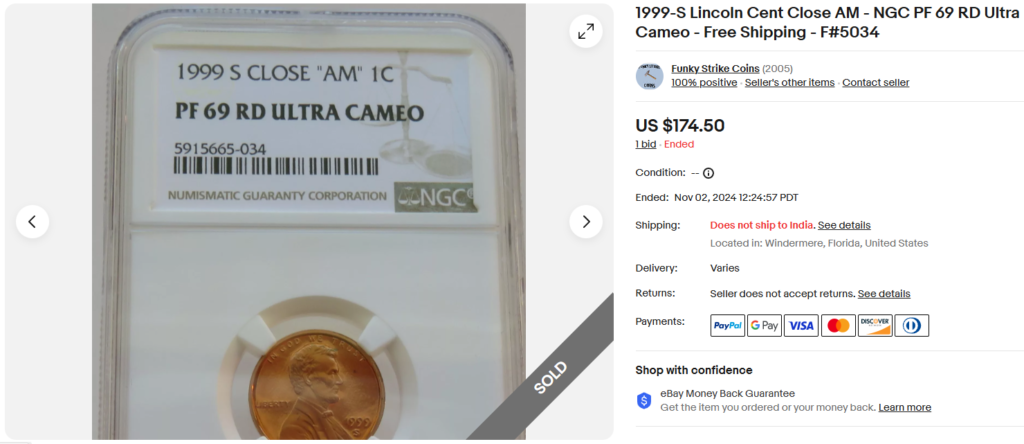
The most expensive 1999 Close AM Lincoln penny proof coin was an MS69 Deep Cameo example sold for $1,035 at Heritage Auctions!
4. Rare 1999 Lincoln Penny Errors:
The 1999 Lincoln cent features several rare minting errors that can significantly increase its value:
Obverse Die Muled With a Roosevelt Dime Reverse
The Lincoln Cent/Roosevelt Dime Mule is one of the most spectacular modern U.S. mint errors. It occurred when a 1999 penny’s obverse die was accidentally paired with a dime’s reverse die in the minting process. This mistake happened at the Philadelphia Mint, where both denominations were being struck.
The front of this rare coin shows the normal Lincoln design, while the back displays the Roosevelt dime’s torch design and “ONE DIME” lettering, appearing slightly distorted since it was struck on the smaller penny planchet. The coin maintains penny specifications.
Value and rarity make this error exceptional – only about 10-12 examples are known to exist. At Heritage Auctions, this rare coin was sold for an eye-popping price of $138,000!
The Wide AM Variety (FS-901)
As the name indicated, the 1990 Wide AM penny show distinct spacing between the letters A and M in “AMERICA” on the reverse. This error likely occurred when a proof reverse die was mistakenly used to strike circulation coins. Such error coins can fetch several hundred dollars if in uncirculated condition.
For example, MS64RD Wide AM pennies typically sell for $100-280, while MS65RD and MS66 red examples can reach $200-450 and MS67 examples can reach $1,200 or more. The rarest MS68 1999 1C Wide AM can fetch up to $4,500 or more, like this example bought for $4,582 at Legend Rare Coin Auctions!
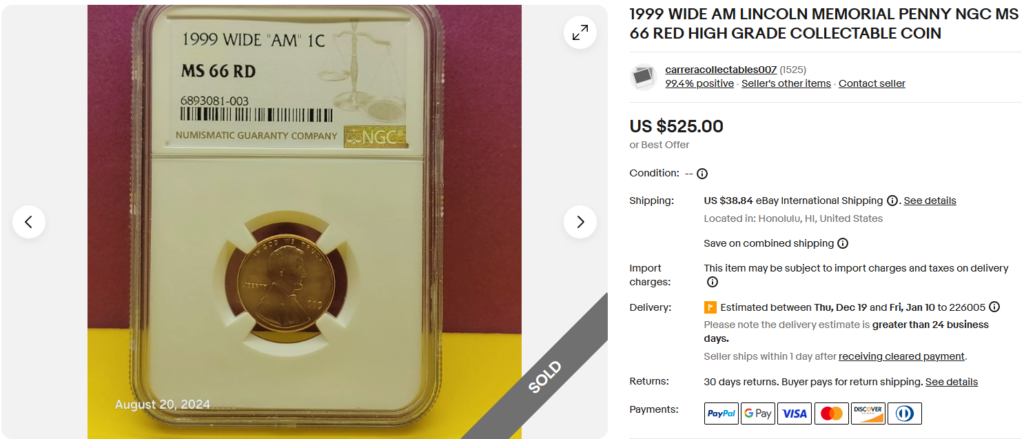
Die Cap with a Second Coin Bonded
A fascinating minting error that occurs when a penny becomes stuck to a die, causing a second coin to be bonded to the first. This can create a dramatic coin with capped edges (like a bottle cap) with disrupted design that can bring $500-2,000 or more, like this MS64Rd example sold for $920 on Heritage Auctions!
Struck on a 1999-P Dime
This extremely rare error occurs when a penny is mistakenly struck on a 1999-P Clad Dime planchet. You can spot this rare coin with its silvery gray surface and its weight of 2.25 grams instead of 2.5 grams and a smaller planchet. These rare coins can be worth $500 to a few thousand dollars. An MS64 1999 Lincoln Cent struck on 1999-P Dime sold for $546!
Double Die Error
Doubled Die Obverse (DDO) or Doubled Die Reverse varieties show distinct doubling in the design elements like the letters in “LIBERTY,” “IN GOD WE TRUST” and “UNITED STATES OF AMERICA” and images. Strong 1999 Lincoln penny doubled dies can bring $50-300, depending on the doubling’s prominence and the coin’s condition.
Double Struck with Second Strike Off-center
A double-struck 1999 Lincoln penny is one that has been struck twice by the press, leading to a faint second image or overlap of the design. This error gets more dramatic when the coin is rotated before the second die, causing it to be relatively off-center.
These errors can be worth $100 or more, depending on the clarity of the second strike, like this MS65 Red example with Second Strike 34% off-center sold for over $410 on Heritage Auctions!
Note: This article is intended for informational, educational, and entertainment purposes only. Some images are illustrative and may not represent actual brands, products, or related entities. All trademarks, product names, brand logos, packaging, and other intellectual property referenced remain the exclusive property of their respective owners. Any brand mentions or references are provided solely for descriptive and educational context and do not imply any formal or commercial association.



